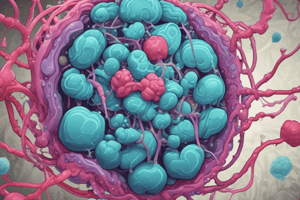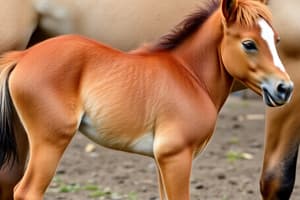Podcast
Questions and Answers
Which cellular form is Rhodococcus typically found in when grown on solid media?
Which cellular form is Rhodococcus typically found in when grown on solid media?
- Pleomorphic
- Coccoid (correct)
- Filamentous
- Bacillary
What is a typical characteristic of Rhodococcus colonies grown on non-enriched media?
What is a typical characteristic of Rhodococcus colonies grown on non-enriched media?
- Irregular and dry
- Filamentous and rough
- Large, flat, and opaque
- Small, shiny, round, and mucoid (correct)
What is a typical biochemical characteristic of Rhodococcus regarding carbohydrate fermentation?
What is a typical biochemical characteristic of Rhodococcus regarding carbohydrate fermentation?
- Ferments lactose rapidly
- Ferments only glucose
- Does not ferment carbohydrates (correct)
- Ferments a wide range of carbohydrates
What disease is most commonly caused by Rhodococcus equi in foals?
What disease is most commonly caused by Rhodococcus equi in foals?
What is the primary mode of R. equi acquisition in foals leading to bronchopneumonia?
What is the primary mode of R. equi acquisition in foals leading to bronchopneumonia?
In addition to bronchopneumonia, which other condition can result from swallowing large numbers of R. equi?
In addition to bronchopneumonia, which other condition can result from swallowing large numbers of R. equi?
What is the typical staining characteristic of Rhodococcus species?
What is the typical staining characteristic of Rhodococcus species?
Besides foals, in which other animal species has superficial abscessation been associated with Rhodococcus equi?
Besides foals, in which other animal species has superficial abscessation been associated with Rhodococcus equi?
Which age group of foals is most susceptible to Rhodococcus equi infection due to impaired cellular immunity of the lungs?
Which age group of foals is most susceptible to Rhodococcus equi infection due to impaired cellular immunity of the lungs?
What is a characteristic of Rhodococcus equi regarding its surface antigens?
What is a characteristic of Rhodococcus equi regarding its surface antigens?
Which of the following is NOT a typical clinical sign of Rhodococcus equi infection in foals?
Which of the following is NOT a typical clinical sign of Rhodococcus equi infection in foals?
What is the primary disease process associated with Rhodococcus equi infection in foals?
What is the primary disease process associated with Rhodococcus equi infection in foals?
What is a characteristic radiographic finding in foals affected by Rhodococcus equi pneumonia?
What is a characteristic radiographic finding in foals affected by Rhodococcus equi pneumonia?
Which medium is used to identify Rhodococcus equi colonies and would be expected to show no growth?
Which medium is used to identify Rhodococcus equi colonies and would be expected to show no growth?
What is a typical characteristic of Rhodococcus equi colonies when grown on blood agar?
What is a typical characteristic of Rhodococcus equi colonies when grown on blood agar?
What finding on a quantitative fecal culture would indicated Rhodococcus equi infection?
What finding on a quantitative fecal culture would indicated Rhodococcus equi infection?
Flashcards
Rhodococcus Morphology
Rhodococcus Morphology
Gram-positive bacteria that can appear in various shapes, from round (cocci) to rod-like (bacilli).
Rhodococcus Capsule
Rhodococcus Capsule
A bacterial capsule is a protective layer outside the cell wall. In Rhodococcus, this capsule is made of layers, like a layered pastry.
Rhodococcus Growth
Rhodococcus Growth
The ability to grow on simple media without additional nutrients. They are self-sufficient, like a picky eater who only needs basic ingredients.
Rhodococcus Colonies
Rhodococcus Colonies
Signup and view all the flashcards
Rhodococcus Catalase
Rhodococcus Catalase
Signup and view all the flashcards
Rhodococcus Equi Infection
Rhodococcus Equi Infection
Signup and view all the flashcards
Rhodococcus Equi Transmission
Rhodococcus Equi Transmission
Signup and view all the flashcards
Rhodococcus Equi Pathogenicity
Rhodococcus Equi Pathogenicity
Signup and view all the flashcards
Rhodococcus equi
Rhodococcus equi
Signup and view all the flashcards
Susceptible Foals
Susceptible Foals
Signup and view all the flashcards
Lung Abscessation
Lung Abscessation
Signup and view all the flashcards
Clinical Signs of Rhodococcus equi
Clinical Signs of Rhodococcus equi
Signup and view all the flashcards
Intracellular Pathogen
Intracellular Pathogen
Signup and view all the flashcards
Diagnosis of Rhodococcus equi
Diagnosis of Rhodococcus equi
Signup and view all the flashcards
Bacterial Culture
Bacterial Culture
Signup and view all the flashcards
Colony Appearance
Colony Appearance
Signup and view all the flashcards
Study Notes
Genus Rhodococcus V. MICRO 152
- Rhodococcus is a genus of bacteria
- Gram-positive, pleomorphic bacteria (cocci to bacilli)
- Cocci on solid media; bacilli in fluids
- Large, non-motile
- Variably acid-fast, stains readily with dyes
- Non-spore-forming
- Lamellar capsule typically present
Cultural Characteristics
- Aerobic, grows well on non-enriched media
- Colonies: small, shiny, round, smooth, mucoid, raised, moist, translucent, regular outline
- Non-hemolytic, larger mucoid and salmon-pink in color with age
- Metachromatic granules often present in milk cultures
Biochemical Characteristics
- Catalase-positive
- Usually oxidase-negative (cytochrome)
- Does not ferment carbohydrates
- Reduces nitrates
- Indole-negative
Rhodococcus equi, Blood Agar
- A visual representation of Rhodococcus equi on blood agar
- Shows colonies and their characteristics
CAMP Phenomenon
- Rhodococcus equi is positive in the CAMP test with Staphylococcus aureus
Morphology (SDA)
- Resembles Nocardia species
- Gram-positive
- Filamentous fragments into rods and cocci forms
- May branch, partially acid-fast by MK
Rhodococcus equi in Sheep Blood Agar
- Visual representation of Rhodococcus equi culture on sheep blood agar
- Shows growth and characteristics
Usual Habitat
- Soil
- Intestinal tracts of animals
Diseases and Host
- Foals (1-4 months old): suppurative bronchopneumonia, pulmonary abscessation. Habitat is soil & feces of other herbivores.
- Horses: superficial abscessation. Habitat is as above.
- Pigs (cattle): mild cervical lymphadenopathy. Habitat is soil.
- Cats: subcutaneous abscesses, mediastinal granulomas
Suppurative Bronchopneumonia of Foals
- Major disease caused by Rhodococcus equi (pyogenic organism)
- Affected foals (1–4 months of age) characterized by bronchopneumonia and lung abscessation
- Acquired by inhalation of dust contaminated with R. equi
- Granulomatous ulcerative enterocolitis and mesenteric lymphadenitis when large numbers of R. equi swallowed from sputum
Pathogenicity and Pathogenesis
- Foals under 4 months are most susceptible due to impaired cellular immunity of the lungs
- Intracellular pathogen with specific surface antigens encoded in the DNA of a large plasmid
- Surface antigens are temp-dependent and expressed at 34–41°C
- Capsular polysaccharides and mycolic acids in the cell wall retard phagocytosis and exoenzyme activity
Clinical Signs
- Acute disease seen in one-month-old foals
- Sudden onset of fever, anorexia, and signs of bronchopneumonia
- Disease is insidious in 2–4-month-old foals; lesions advanced before coughing, dyspnea, weight loss, and exercise intolerance
- Characteristic loud, moist rales on auscultation
- Occasionally diarrhea
Disease Process
- Bronchopneumonia with local abscessation
- Formation and distribution of abscessation
- Non-pulmonary disorders
Radiographic Appearance
- Normal foal chest X-ray
- Foal chest X-ray affected with Rhodococcus equi showing multiple abscesses in the lungs
Postmortem Appearance
- Foal that died due to Rhodococcus equi pneumonia
- Shows presence of multiple coalescing large abscesses within the lung
- Image shows appearance of affected lungs
Diagnosis
- History of the disease on the farm, age of the affected foal, and clinical signs
- Auscultation and radiography of the thorax
- Specimens for laboratory examination (tracheal aspirates and pus from lesions)
- BAP and MCA inoculated with suspect material and incubated aerobically at 37°C for 1–2 days
Identification Criteria
- Colonies on blood agar—non-hemolytic, salmon-pink, and mucoid
- Absence of growth on MCA
- CAMP test-positive
- Unresponsive in the OF test and sugar fermentation tests
- Biochemical profile using commercial kits
- Quantitative fecal culture on a selective medium demonstrating over 106 R. equi/g of feces
Treatment and Control
- Oral rifampin and erythromycin for 4–10 weeks
- Supportive therapy (rehydration, bronchodilatory/expectorant agents)
- No vaccine available
- Foals should be kept under observation
- Remove foal manure from pastures at frequent intervals
- Foals and dams should move regularly to fresh pasture
- Administer hyperimmune serum to foals at 1 month of age
Studying That Suits You
Use AI to generate personalized quizzes and flashcards to suit your learning preferences.



